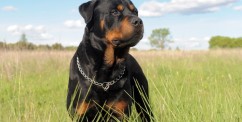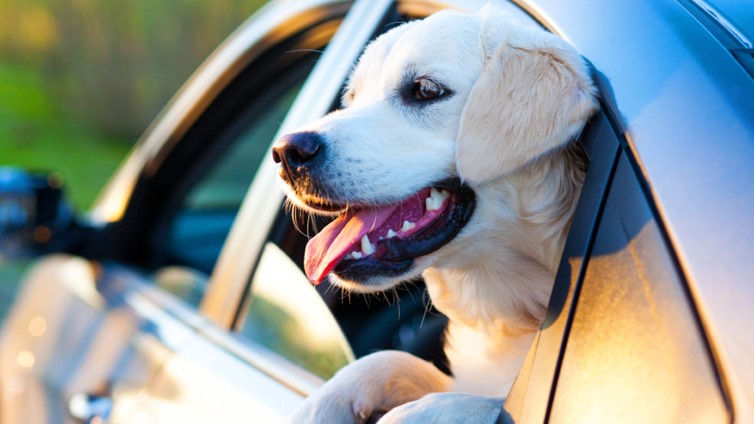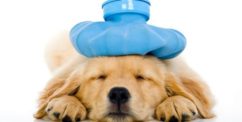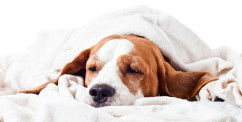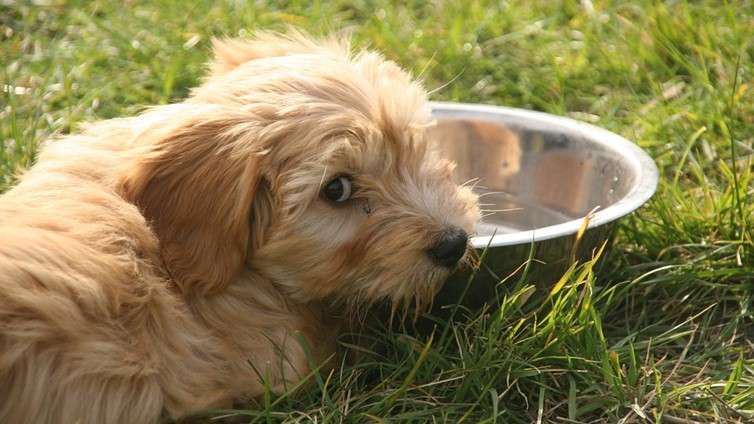It is common for dogs to drink water throughout the day. We all know that dogs are massive food lovers, but they love water equally, and how much water should a dog drink on a daily level?
In this article, we will discuss this question, provide the right answer to this question, and much more.
Let’s discover how much water should dogs drink daily, when drinking too much water is a sign of underlying health issues, and how to stop dogs from drinking too much water.
How Much Water Should Dogs Drink
As a general rule, dogs should drink about 1 ounce of water for every pound that they weigh, every day.
To put this into numbers, if your dog has 10-pounds, he should drink about two-thirds of a 16oz bottle of water on a daily level.
Really active puppies and adult dogs, and in general high-energy breeds such as Border Collie, will usually drink even more water.
Dogs who are pregnant or just recently had puppies often need more water.
It is also common for puppies to drink more water when compared to adult dogs.
The reason for this is that puppies are growing and their bodies are developing, plus their bodies are growing which is why they are more active.
As result, they drink more water. On top of that, if your puppy eats soft food, he might drink slightly less water than usual.
Why is this the case? When puppies (or dogs in general) eat more soft food, they will drink slightly less water, because they are getting more water content from their food.
To help your puppy get the best food possible, make sure that you know how to read dog food labels: this way you will choose the best brand, find faster food that is packed with many nutrients and help you know the difference between food for puppies, adult dogs, and senior dogs.
Food note: Never feed puppies with any other food but puppy food.
Why? Puppies won’t get the nutrition that they need from the food of an adult dog, and vice versa.
Dog’s food should always be based on his age, size, and activity level.
Water Importance For Dogs
Just like in humans, proper water intake is important for overall health.
Water, next to food, is what keeps living beings moving. That being said, the right amount of water is vital for dogs.
Did you know that up to 70% of a dog’s body is made up of water? Or that water is, in fact, the most important nutrient?
Not only that water moisturizes the air in the lungs, but it is also responsible for transporting the oxygen and nutrients in the bloodstream cells.
Next to these functions, water also keeps body temperature in balance and protects internal organs.
Did you know that in both humans and animals water helps eliminate waste from the body?
Now, let’s see how dogs act around drinking water when the temperature rises.
Should Dogs Drink More Water On Hot Days?
If you are an experienced dog owner, you know that you need to care more about your dog on hot summer days.
Dogs do not sweat as humans do. In fact, that heavy breathing that they display during the summer session is how they cool themself.
If you are just stepping inside the world of dog ownership, you should learn about heastroke in dogs, and why keeping your dog cool during the summer should be your main goal.
No matter if you are a novice owner or an experienced one, you should provide your dog with a bowl of clean and fresh water throughout the year. Moreover, extra attention should be put on summer days, because just like humans, dogs do drink more water on hot days.
On hot summer days, especially after a nice run or a play time session, or a walk to the dog park and back, your Fido will choose to drink more water.
On these days make sure that your dog has enough shade and easy access to fresh water.
Just like humans, dogs use water to regulate their temperature, digest their food, and stay hydrated.
Signs Of Dehydration In Dogs
Can dogs be dehydrated? Simply said, yes.
Dogs are living beings, and just like humans, they need water to live. Otherwise, their bodies will experience many downsides.
If you think that your dog might be dehydrated, make sure that you contact your veterinarian.
Also, if your dog seems mildly dehydrated but there is no vomiting, give your dog a small amount of water: one teaspoon for small size dogs, two tablespoons for larger dogs, and repeat that every ten minutes for a few hours.
Make sure that your veterinarian approves this method, and do your best to monitor the dog closely.
If you notice any vomiting, make sure that you contact your veterinarian immediately.
When it comes to dehydration in dogs, it’s crucial not to force the dog to drink a huge amount of water rapidly.
Drinking too much, or too fast may lead to the dog experiencing vomiting, which will lead to dehydration. Not sure how to recognize dehydration in dogs?
Here are the four most common signs that your dog is dehydrated:
- Vomiting
- Thick saliva
- Dry gums and dry tongue
- Heavy sleepiness and unwillingness to play
Now, let’s see what it means when your dog starts drinking water intensively.
How Should I Check For Dehydration?
This check is easy and fast. All that you need to do is gently pull back the skin of your dog’s neck and let it go.
If the skin snaps back into place quickly, it means that your dog is hydrated.
On the other hand, if your dog’s skin returns slowly and creates something that is known as ‘skin fold’ it means that your dog is dehydrated.
The second best way to check if your dog is hydrated or not is to check his gums. Healthy gums are slippery, while sticky gums are a sign of dehydration.
Why Is Your Dog Thirsty?
In some cases, dogs may choose to drink more water just because they are thirsty.
In other cases, dogs may drink more water after a heavy or very dry meal. Also, during the summertime dogs tend to drink more water than usual.
This is something that happens in humans as well, so it is something that is easy to understand.
Also, after a good run, dogs may drink more water. All in all, different factors will affect a dog’s ability to drink water, and how large amounts are.
If your dog excessively starts to drink water you should monitor him closely. Increased thirst may be a sign of underlying issues in your dog.
Dog Drinking Lots Of Water Suddenly

If you notice that you are filling the water bowl more often than usual, you should know that your dog just drinks more water than usual.
Do you have a feline as well? If so, this may be a sign that your cat drinks more water than usual, so check it.
Still, if your home is dog-only, you might contact your veterinarian because excessive thirst may be a sign of an underlying disease.
Drinking an excessive amount of water is usually followed by urinating more than usual.
If this happens, let your veterinarian know. The causes for this may vary from dog to dog, which is why a full physical examination is mandatory.
Your veterinarian will probably conduct a blood or urine test that should define the next steps.
Your veterinarian might ask you to measure your dog’s water intake. If this happens, and your home is a multi-pet household, you might separate the dog’s bowl from other pets.
Even if your dog drinks a huge amount of water, you should still provide easy access to the water bowl. Just make sure that you monitor your dog closely.
What Does It Mean When An Older Dog Starts Drinking A Lot Of Water?
Older dogs are prone to several different conditions. Senior dogs are highly sensitive to a number of various factors, including weather, indoor conditions, and even external factors that one can’t control.
These lovely creatures are especially sensitive to routine change and once your dog reaches his senior years, you should do your best to keep his days as calm as possible.
In senior dogs, excessive water drinking is usually a of an underlying health issues, such as:
- Kidney failure
- Diabetes mellitus
- Cushing’s syndrome
- Dehydration
- Urinary tract infections or bladder disease
To know when you should react, monitor your dog closely for the listed symptoms:
- Dehydration
- Liver disease
- Cancer
- Infection
- Fever
- Medications, including steroids and diuretics
- Heatstroke or hyperthermia
- Diabetes insipidus
- Hyperthyroidism
- Parasites
- Hypercalcemia
Conditions listed in this section are treatable, and treatment will depend on the overall dog’s health and current condition.
The underlying cause will mostly define the treatment, recommended medication, and overall treatment.
As a general rule, senior dogs aren’t heavily active.
Even high-energy breeds, such as Border Collie or German Shepherd are more chill and couch potatoes once they reach their senior years.
Although they may not be ready to jump for every walk like they used to, they will still s a regular water intake.
Senior dogs are all about routine, and even their food and water intake are every day the same. Even if they find it hard to move to their bowl, it’s up to you to provide them with the right amount of water.
In practice, this means that if necessary you should move the bowl to your dog. Also, make sure that you provide the right food for senior dogs.
Choose pet moist food, as your dog will receive water while eating. While you are minding your senior dog’s diet, make sure that you provide enough exercise as well.
Senior dogs should exercise regularly, and up to their ability.
They may not be mobile like in their younger days, but keeping their joints healthy and strong should be an imperative.
How To Stop Dog From Drinking Too Much Water?
The best option would be not to stop your dog from drinking water. Dogs should know naturally how to protect their bodies and when they had enough water, or not.
Still, if your veterinarian recommends stopping a dog from drinking too much water, you should do it.
Here are some ideas on how to achieve this:
- Use pet fountains
- Using additional water bowls
- Using bowls of different materials
- Adding ice cubes to the water
- Monitor your dog
- Refill dog’s bowl at same time daily
- Always refill bowl to identical level
Once again: unless your veterinarian recommends it for specific reasons, you shouldn’t ever restrict your dog’s water intake.
Do Dogs Sweat?
Dogs have their own way of dealing with sweat. Dogs have sweat glands in their paw pads.
Their paws are smaller in size and as such don’t have much surface area to cool them down, so they have to be creative to cool down. They achieve this by panting. Through panting dogs expel the heat.
Panting allows the air to reach their tongue and mouth, and they achieve to cool down more quickly. This is how they deal with internal heat.
Opposite to dogs, cats also sweat through their paws, but they choose to use more mental tactics to cool off like using cooler surfaces, using a shady spot, and drinking more water.
This is something that dogs might also do, but they will do it more often if they share their space with felines.
Keep Your Dog’s Water Clean And Fresh
Some dogs have really high standards when it comes to their accessories.
How often do you clean a dog’s bowl for water and food? If you cannot remember, it means that you should probably do it a bit often.
In most cases, dogs won’t make too much fuzz if you miss cleaning their bowl once a month, while some will prefer it to be cleaned once a week – it is highly individual and will vary from dog to dog.
Dogs may care more about the water’s freshness than anything else. Do you enjoy stale water? Neither does your dog. That being said, do your best to always provide fresh water.
Once you get up replace the overnight water with a fresh one. If it is too hot, place a few ice cubes once your dog has that first-morning sip. This way you may prolong water freshens. Also, replace water during the day and in the evening, before you go to bed.
If this sounds like too much work for you, you can always think about smart gadgets. This means that you can use a water fountain.
How Often Should You Clean The Water Bowl?
Some dog experts will suggest that you clean dog food and water bowls daily with soap and water.
You don’t have to scrub them for hours, cleaning of a few seconds should be more than fine to keep these items clean.
Bowls are easy to clean as their materials are commonly smooth. Thanks to their shape bacteria cannot have hidden places to hide and survive.
Still, water makes a great space for bacteria to thrive, which is why regular cleaning is so important.
Water and dogs alive are a great duo for bacterial ground. By keeping dog’s bowls clean you are keeping your dog healthy.
Speaking of Bacteria… What If Your Dog Drinks From The Toilet?
Dogs do unusual things. You do have to be an experienced dog owner, to know that sometimes… Dogs are just being weird!
Some of them, like Basenji, might act like cats, some are tall as a kitchen counter (think about Great Dane) which is why they may frequently have stomach issues (from food grabbing), while some choose to act weird – like making a funny noise, acting like a clown, or just drinking water from her toiler…
Is this something that you should be worried about or not? All in all, if your dog takes a sip from the toilet, there should not be any health issues, as long as the toilet is without any content (waste).
It’s no secret that toilets harbor various bacteria, models, and other stuff that may affect everyone’s health and well-being you should never allow your dog to drink from ht toilet, not even as an accident.
It is always better to prevent any condition than to treat it afterward.
Are you on the lookout for an easy solution? Just put the toilet seat and cover down, and voila!
Do not let your dog enter the bathroom, or have any sort of access to the toilet.
The Bottom Line
The best way to keep your dog well-hydrated and his organism strong is to help the home have easy access to fresh and clean water.
If you don’t provide this your Fido will try to get to the toilet water.
If you are serious about keeping your dog healthy and strong you need to think about keeping him hydrated, which keeps everyone happy.





